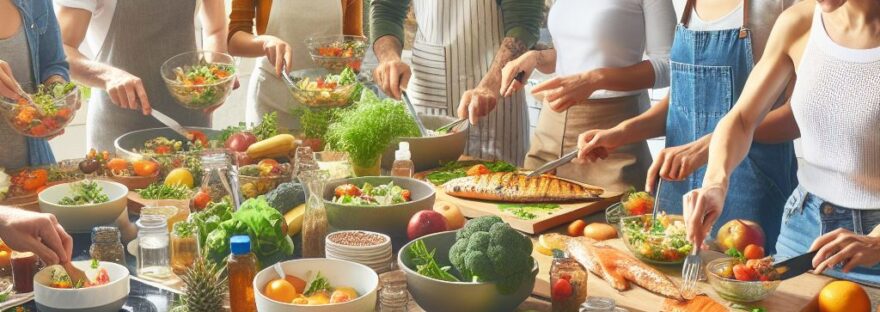Maintaining a healthy heart is crucial for overall well-being, and a balanced diet plays a significant role in achieving this. As an expert nutritionist, I’m excited to share some heart-healthy recipes that not only support cardiovascular health but also contribute to holistic wellness. These recipes are designed to be delicious, nutritious, and easy to prepare, making it simple to incorporate them into your daily routine.
1. Avocado and Berry Smoothie
Ingredients:
- 1 ripe avocado
- 1 cup mixed berries (strawberries, blueberries, raspberries)
- 1 cup spinach
- 1 cup almond milk (unsweetened)
- 1 tablespoon chia seeds
- 1 teaspoon honey (optional)
Instructions:
- Scoop out the avocado and place it in a blender.
- Add the mixed berries, spinach, almond milk, and chia seeds.
- Blend until smooth. Add honey if desired for extra sweetness.
- Pour into a glass and enjoy a nutrient-packed start to your day.
Benefits: This smoothie is rich in antioxidants, healthy fats, and fiber, which help reduce inflammation and support heart health.
2. Quinoa and Black Bean Salad
Ingredients:
- 1 cup quinoa
- 1 can black beans, rinsed and drained
- 1 red bell pepper, diced
- 1 small red onion, finely chopped
- 1 cup corn kernels (fresh or frozen)
- 1 avocado, diced
- 1/4 cup fresh cilantro, chopped
- Juice of 2 limes
- 2 tablespoons olive oil
- Salt and pepper to taste
Instructions:
- Cook the quinoa according to package instructions and let it cool.
- In a large bowl, combine the quinoa, black beans, bell pepper, red onion, corn, and avocado.
- In a small bowl, whisk together the lime juice, olive oil, salt, and pepper.
- Pour the dressing over the salad and toss to combine.
- Garnish with fresh cilantro and serve.
Benefits: Quinoa is a complete protein and high in fiber, while black beans provide additional protein and fiber. This salad is a great source of vitamins, minerals, and healthy fats, making it perfect for heart health.
3. Baked Salmon with Garlic and Herbs
Ingredients:
- 4 salmon fillets
- 2 tablespoons olive oil
- 4 cloves garlic, minced
- 1 tablespoon fresh dill, chopped
- 1 tablespoon fresh parsley, chopped
- Juice of 1 lemon
- Salt and pepper to taste
Instructions:
- Preheat the oven to 375°F (190°C).
- Place the salmon fillets on a baking sheet lined with parchment paper.
- In a small bowl, mix together the olive oil, garlic, dill, parsley, lemon juice, salt, and pepper.
- Brush the mixture over the salmon fillets.
- Bake for 15-20 minutes, or until the salmon is cooked through and flakes easily with a fork.
- Serve with a side of steamed vegetables or a fresh salad.
Benefits: Salmon is rich in omega-3 fatty acids, which are known to reduce the risk of heart disease. The herbs and garlic add flavor and additional health benefits, making this dish both tasty and nutritious.
4. Oatmeal with Fresh Fruits and Nuts
Ingredients:
- 1 cup rolled oats
- 2 cups water or milk (dairy or plant-based)
- 1/2 teaspoon cinnamon
- 1 apple, diced
- 1/4 cup walnuts, chopped
- 1 tablespoon flaxseeds
- 1 tablespoon honey (optional)
Instructions:
- In a saucepan, bring the water or milk to a boil.
- Add the oats and reduce the heat to a simmer. Cook for about 5 minutes, stirring occasionally.
- Stir in the cinnamon and diced apple. Cook for another 2-3 minutes until the apple is tender.
- Remove from heat and top with walnuts, flaxseeds, and honey if desired.
- Serve warm and enjoy a heart-healthy breakfast.
Benefits: Oats are high in soluble fiber, which helps lower cholesterol levels. The addition of fruits and nuts provides essential vitamins, minerals, and healthy fats, making this a balanced and heart-friendly meal.
5. Mediterranean Chickpea Stew
Ingredients:
- 1 can chickpeas, rinsed and drained
- 1 can diced tomatoes
- 1 small onion, chopped
- 2 cloves garlic, minced
- 1 zucchini, diced
- 1 red bell pepper, diced
- 1 teaspoon ground cumin
- 1 teaspoon paprika
- 2 tablespoons olive oil
- 1 cup vegetable broth
- Fresh parsley for garnish
- Salt and pepper to taste
Instructions:
- In a large pot, heat the olive oil over medium heat.
- Add the onion and garlic, and sauté until softened.
- Stir in the cumin and paprika, and cook for another minute.
- Add the chickpeas, diced tomatoes, zucchini, bell pepper, and vegetable broth.
- Bring to a boil, then reduce the heat and simmer for 20-25 minutes until the vegetables are tender.
- Season with salt and pepper to taste.
- Garnish with fresh parsley and serve.
Benefits: Chickpeas are a great source of plant-based protein and fiber, which help maintain healthy cholesterol levels. This stew is packed with vegetables and spices that provide antioxidants and anti-inflammatory properties, supporting overall heart health.
Conclusion
Incorporating these heart-healthy recipes into your diet can significantly improve your cardiovascular health and contribute to holistic wellness. Remember, the key to a healthy heart is a balanced diet rich in fruits, vegetables, whole grains, lean proteins, and healthy fats. By making conscious food choices and enjoying a variety of nutritious meals, you can support your heart and overall well-being.




